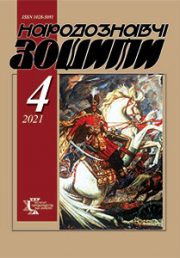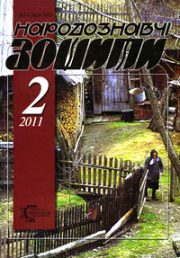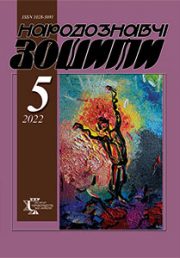The Ethnology Notebooks. 2024. № 2 (176), 426—433
UDK 398(=161.2):599.323.7
DOI https://doi.org/10.15407/nz2024.02.426
IMAGE OF A ZINSKE PUPPY IN UKRAINIAN FOLKLORE: ETYMOLOGY AND GENESIS
HALAICHUK Oksana
- ORCID ID: https://orcid.org/0000-0001-8052-6616
- Ph.D. of Sciences in Philology,
- Researcher of the International Institute of Education,
- Culture and Diaspora Relations of Lviv Polytechnic National University,
- 32, Stepana Bandery street, 79000, Lviv, Ukraine,
- Contacts: e-mail: ok_halaychuk@ukr.net
Abstract. The article is devoted to the analysis of the zoomorphic image of the zins’ke schenia (Spalax) in Ukrainian folklore and ethnographic texts. The author emphasizes the lack of awareness of Ukrainians about this animal in general and the insignificant coverage of its image in oral folklore in particular, which is the relevance of the study. It has been found that the zins’ke schenia is sometimes considered a non-existent, mythical animal, dangerous to humans. The purpose of the article is to expand the Ukrainian bestiary with a little-known animal image. The tasks are to investigate the etymology of the name «zins’ke schenia on the basis of lexicographic material; to identify and characterize the image of the zins’ke schenia in folklore and ethnographic texts and to trace the ideas of Ukrainians about the origin of this animal.
The article reveals the meaning of the name «zins’ke schenia». It is stated that there is no consensus among scholars on the interpretation of this zoonim. On the basis of various folklore genres, the author analyzes the image of the zins’ke schenia. An attempt is made to reconstruct the cycle of stories about zins’ke schenia on the basis of fairy-tale and legendary folklore texts. The reproduction of this zoomorphic image in the works of Ukrainian fiction is traced. The issue of using the animal in folk medicine is considered. To realize this goal, both general scientific and linguistic methods of research were used: comparative and historical, descriptive, and complex analysis.
Keywords: image, zins’ke schenia, spalax, Ukrainian folklore, symbol, worldview, spiritual culture, folk medicine.
Received 22.02.2024
REFERENCES
- Vahylevych, I. Slavic symbols. Lviv National Library named after V. Stefanyk. Department of manuscripts. I. Vahylevych Fund. Vol. 7. Folder 34. Arc. 43 [in Polish].
- Sumtsov, M. (1890). The Raven in folklore. An ethnographic review, 1 (Book 4, pp. 61—86). Moscow [in Russian].
- Bulashev, H. (1992). Ukrainian people in their legends, religious views and beliefs. Kyiv: Dovira [in Ukrainian].
- Kurochkin, O. (1995). Ukrainian New Year’s rituals: «Goat» and «Malanka». Opishne: Ukrainian ethnology [in Ukrainian].
- Pastukh, N. (2013). Symbolism of animals in Ukrainian folklore: the cuckoo. Lviv: Institute of Ethnology of National Academy of Sciences of Ukraine [in Ukrainian].
- Slipushko, O. (2001). Ancient Ukrainian bestiary (animal dictionary). Kyiv: Dnipro [in Ukrainian].
- Hromova, N. (2019). Ukrainian traditional ideas about the origin of animals. Ethnic history of the peoples of Europe, 58, 38—45 [in Ukrainian].
- Levchuk, O. (2021). The image of a horse in the system of zoomorphic symbolism of Ukrainian folklore (PhD in Philology). Ivan Franko National University of Lviv [in Ukrainian].
- Petrov, V. (1928). New Ukrainian variants of the legend about the origin of evil women. Ethnographic Bulletin, 6, 55—66 [in Ukrainian].
- Nomys, M. (1993). Ukrainian sayings, proverbs, and so on. Kyiv: Lybid [in Ukrainian].
- Kvitka-Osnovianenko, H. Konotop Witch: A Novel. Retrieved from: https://osvita.ua/school/literature/k/69786/list-5.html (Last accessed: 25.02.2024).
- Honchar, O. (2004). Diaries (Vol. 3). Kyiv: Veselka [in Ukrainian].
- Vyshnia, Ostap. Smiles of Kyiv. Retrieved from: https://lib.com.ua/uk/book/usmishki-kiyivski/?page=8 (Last accessed: 22.02.2024).
- Blyznets, V. The Boy and the Shadow. Retrieved from: https://www.ukrlib.com.ua/books/printit.php?tid=4789&page=7 (Last accessed: 22.02.2024).
- Slipak, Slipets, Zinske shchenia. Wikipedia. Retrieved from: https://uk.wikipedia.org/wiki/%D0%A1%D0%BB%D1%96%D0%BF%D0%B0%D0%BA (Last accessed: 15.01.2024).
- Hrinchenko, B. (1996). Dictionary of the Ukrainian language (Vol. 2). Kyiv: Naukova dumka [in Ukrainian].
- (1985). Etymological dictionary of the Ukrainian language (Vol. 2). Kyiv: Naukova dumka [in Ukrainian].
- Yavornytskyi, D. (1920). Dictionary of the Ukrainian language (Vol. 1). Katerynoslav: Slovo [in Ukrainian].
- Taranenko, O. (2004). Ukrainian lexicography of 1917 — early 21st century. In: Ukrainian language: encyclopedia. Kyiv: M.P. Bazhan Ukrainian Encyclopedia Publishing House [in Ukrainian].
- Sharleman M., & Tatarko, K. (1927). Dictionary of zoological nomenclatur (Vol. 2). Kyiv: State Publishing House of Ukraine [in Ukrainian].
- (1972). Zinsky. In: Dictionary of the Ukrainian language (Vol. 3). Retrieved from: https://sum.in.ua/s/zinsjkyj (Last accessed: 21.01.2024).
- Korobchenko, M. (2015). Local names of rodents of the genus Spalax in eastern Ukraine: zins’kе schenia, slipets, slipak, mole. Novitates Theriologicae, 9, 105—111 [in Ukrainian].
- Barabash-Nykyforov, I. (1928). Essays on the faunas of the steppe Naddniprianshchyna (former Ekaterinoslavshchyna). Kyiv: State Publishing House of Ukraine [in Ukrainian].
- Onatskyi, Ye. (1959). Ukrainian Small Encyclopedia (Book IV). Buenos Aires [in Ukrainian].
- Radko, H. (2017). The Cycle of Good and Evil, Love and Hate in a Book of Short Fiction by Natalka Fursa. Native land, 1 (40), 215—218 [in Ukrainian].
- (1999). Sich treasury. Legends and tales of the Lower Naddniprianshchyna. Zaporizhzhia: Zaporizhzhia State University [in Ukrainian].
- Sementsov, M. (2006). Folk experience of rational use of wildlife in the conditions of development of the Kuban by the Cossacks (XIX—XX centuries). The Donetsk Bulletin of the Shevchenko Scientific Society, 12, 243—264 [in Ukrainian].
- Sokolov, M. (1916). Information about the domestic life of the lower class of inhabitants, mainly state peasants and Cossacks in Poltava uyezd, also folk legends and monuments. In: Zelenin, D. Description of manuscripts of the scientific archive of the Imperial Russian Society (Issue 3, pp. 1111—1118) [in Russian].
- Talko-Hryncewicz, J. (1893). Outlines of folk healing in Southern Ruthenia. Krakow: Academy of Skills [in Polish].
- Onyshchuk, A. (1909). Materials for Hutsul demonology. Recorded in Zelenytsia, Nadvirna district, 1907—1908. Materials for Ukrainian ethnology (Vol. XI, part 2, pp. 1—139) [in Ukrainian].
- Hnatiuk, V. (1902). Galician-Ruthenian folk legends. In: Ethnographic collection (Vol. 2, part 13) [in Ukrainian].






